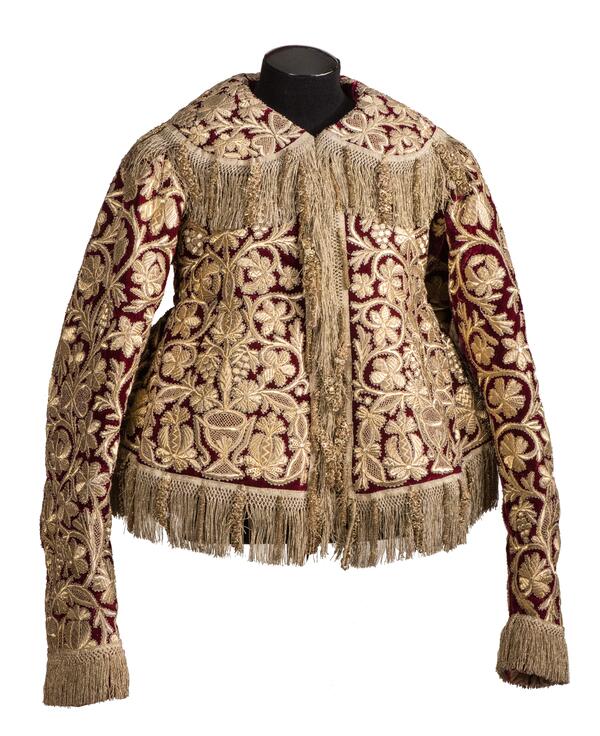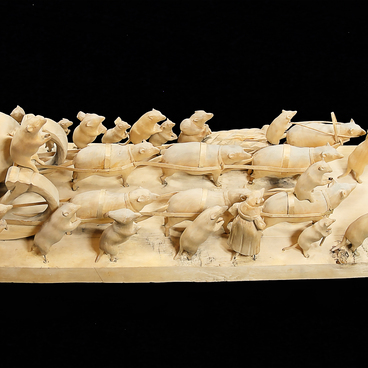In the 19th century, in many regions of Russia, including the Nizhny Novgorod Governorate, the well-off peasantry, middle-class merchants and city dwellers wore a “sarafan” version of a festive costume. A shugay was an important part of this lavish attire. A shugay was believed to signify high status and demonstrate the wealth of its owner.
A shugay is a kind of jacket with long sleeves, a large collar and a cut-off back at the waist or at the level of the shoulder blades with ruffs below the cut line, usually at the back.
Nizhny Novgorod shugays are distinguished by a special design: a set-in puffy sleeve, large rollers called “bory” on the back, and a padded cotton lining. Horsehair was used as a filler for the padding. Less often it was cotton wool, which was then a very expensive material. The shugay from the collection of the Russian Museum is a unique work of art. Its design is similar to the items made from factory fabrics, but, unlike typical brocade fabrics, it is sewn from bright red velvet and richly decorated with gold embroidery. The round collar, clasp and hem of the shugay are trimmed with stripes of fringe made of gold threads. There are additional scrolled pendants — “vorvorkas”. Such pendants were rather expensive textile ornaments. They were rarely used in the decor of a peasant costume. This suggests that the “vorvorkas” were more of a luxury item than a regional tradition.
Products similar to the Nizhny Novgorod shugay, as well as festive headdresses, were embroidered in the monastic workshops of the Nizhny Novgorod region. This shugay was probably created in one of Arzamas monasteries. It was not to be sold at the fair, but was rather a very expensive commission. Embroidering the gold elements of a festive costume required not only embroidery, but also outstanding sewing skills. In the world, there are no more than three or four shugays embroidered with gold threads, similar to the exhibit of the Russian Museum. The value of the Nizhny Novgorod shugay was already obvious in the 19th century: in the 1880s, it was exhibited in the Museum of Baron A.L. Stieglitz.
A shugay is a kind of jacket with long sleeves, a large collar and a cut-off back at the waist or at the level of the shoulder blades with ruffs below the cut line, usually at the back.
Nizhny Novgorod shugays are distinguished by a special design: a set-in puffy sleeve, large rollers called “bory” on the back, and a padded cotton lining. Horsehair was used as a filler for the padding. Less often it was cotton wool, which was then a very expensive material. The shugay from the collection of the Russian Museum is a unique work of art. Its design is similar to the items made from factory fabrics, but, unlike typical brocade fabrics, it is sewn from bright red velvet and richly decorated with gold embroidery. The round collar, clasp and hem of the shugay are trimmed with stripes of fringe made of gold threads. There are additional scrolled pendants — “vorvorkas”. Such pendants were rather expensive textile ornaments. They were rarely used in the decor of a peasant costume. This suggests that the “vorvorkas” were more of a luxury item than a regional tradition.
Products similar to the Nizhny Novgorod shugay, as well as festive headdresses, were embroidered in the monastic workshops of the Nizhny Novgorod region. This shugay was probably created in one of Arzamas monasteries. It was not to be sold at the fair, but was rather a very expensive commission. Embroidering the gold elements of a festive costume required not only embroidery, but also outstanding sewing skills. In the world, there are no more than three or four shugays embroidered with gold threads, similar to the exhibit of the Russian Museum. The value of the Nizhny Novgorod shugay was already obvious in the 19th century: in the 1880s, it was exhibited in the Museum of Baron A.L. Stieglitz.



